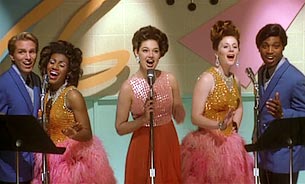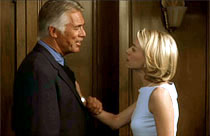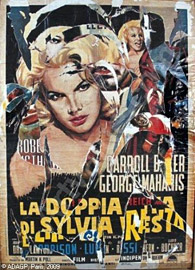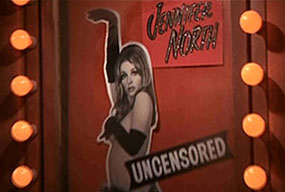|
Threads: The Sylvia North Audition Scene - (the_kid_with_the_helmet) |
|
|
Related: |
Why does Adam in place of Bob Brooker direct the "Sylvia North Story" in Diane's dream?
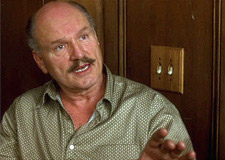 What
we deal here with is a shift of identities.
What
we deal here with is a shift of identities.
Reality:
Diane
and Camilla met on 'TSNS' directed by Bob
Brooker. Camilla got the lead and played
off well while Diane was rejected for her apparent lack of talent. Camilla and
Diane became friends/lovers and since Camilla managed to get Diane bit parts in
some of her subsequent films. That's what we learn at the dinner
party.
Now, Camilla's latest picture (the title is never mentioned) was directed by Adam
Kesher, also featuring Diane in a minor role. Camilla and the director fell in
love and at the film's wrap-up party they announce their engagement.
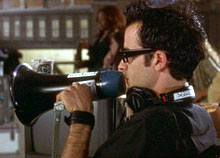 Dream: In
Diane's dream identities got twisted up. Bob Brooker, an acclaimed director whose film
'TSNS' can certainly be called a master piece, is now miming a hapless and inept third-rate
director,
whose flicks don't even make it to the big screen. He only speaks when being
prompted and fails to recognize the great talent of Betty where everyone else
thinks she got star power. This is Diane's way of expressing
her dislike for how Brooker once spoiled her carrier.
Dream: In
Diane's dream identities got twisted up. Bob Brooker, an acclaimed director whose film
'TSNS' can certainly be called a master piece, is now miming a hapless and inept third-rate
director,
whose flicks don't even make it to the big screen. He only speaks when being
prompted and fails to recognize the great talent of Betty where everyone else
thinks she got star power. This is Diane's way of expressing
her dislike for how Brooker once spoiled her carrier.
Bob's real-life part as the director of 'TSNS' is now played by Adam Kesher. Diane dooms him for intruding into her affairs with Camilla. So she lets him experience her own downward path in Hollywood - which essentially incorporates being cheated, losing control, going broke. This way Diane obtains gratification for Adam stealing away Camilla and leaving her life in a mess.
Is Diane so blinded by hatred that it has blurred her perceptions that she can't really distinguish between the two directors, both of whom wronged her, making them as one in her own mind? Or is she, by intermingling Adam and Bob Brooker, envisioning that directors, just as talented actresses such as she, are really just another of the many cogs in the Hollywood film industry machine that are interchangeable and at the mercy of the powerful, sinister, non-artistic, behind the scenes forces who are truly in control of her and others "reality"? - (GoldenBear)
Note the duality:
-
At the audition Bob Brooker explains to Diane: "The two of them with themselves."
-
On set Adam explains to Camilla: "The two of you are alone."
Another explanation is simply that Kesher was replaced by Brooker. When Adam acted out at the meeting, he was told that it was no longer his film, and then Ray asked Roque if he wanted him replaced, adding "... I know they said ...", and Roque says, "Then?" (that is, self evident). So he was ordered back to work because all those people and all that money were involved in the casting and he was permitted to go through the motions of casting the lead. But after his behavior toward the Castiglianes, his presence as director would not be tolerated. During the auditions, in the background, Linney is talking to Ray. Maybe he told her his problems with Kesher and she put a bug in his ear about Brooker, who she figured was probably going to be looking for another job soon anyway. - (Berny_Elms)
The Sylvia North Story through Diane's distorted point of view - (22cute)
Throughout the film, we see either Betty or Diane auditioning for, taken to audition for, or appearing in three "different" movies. I believe all three movies were intended to represent The Sylvia North Story through Diane's distorted point of view, for various reasons.
|
|
|
Bob Brooker's audition |
|
|
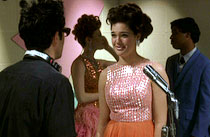
|
|
Adam Kesher's audition |
|
|
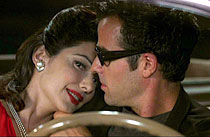
|
|
Adam Kesher's filmset |
-
First we see Betty auditioning for a role in a movie being produced by Wally, a friend of her Aunt Ruth's. When she enters the room, she's introduced to, among others, the director, Bob Brooker, and the person with whom she'll be auditioning, Woody.
I believe Betty is auditioning the scene exactly as Camilla played it in the "real" TSNS. She takes everyone in the room by storm with her performance, with the exception of the director, whose critique is lukewarm, at best. She's also created a scenario where she has upstaged Camilla for the role. (Woody says something like, "Let's play it up nice and close, like we did with the dark-haired girl, Whatshername?".) And finally, she's rationalized why she herself didn't get the part in TSNS - it never got made!
-
Next, we see Betty being escorted "across" by Linney James, Wally's ex-wife and a major casting director, to the set of a movie that Linney predicts Betty will "Kill! Knock right out of the park." Of course, it's it's Adam Kesher's "Sixteen Reasons/I've Told Every Little Star" set.
As Adam's assistant tells him Camilla Rhodes is ready to audition (the Camilla the Castigliane have identified as "This is the Girl), someone calls out, "Camilla Rhodes, Sylvia North Story, Take One.” Of course, in this version, the reason Diane/Betty didn't get the part is that Adam was forced to cast Camilla Rhodes, although his eyes lingered longingly on Betty, both as she came on the set and after he was forced to declare, "This is the Girl."
-
Finally, we saw Diane, in costume and full-make up, on the set of a movie being directed by Adam, in which Camilla was the star and herself a bit player. (This was the scene in which Adam cleared the set and Camilla asked if Diane could stay.)
If you look closely at the set in this version, and then look again at Adam's "I've Told Every Little Star” set, they're both clearly on the same soundstage. I think this was intended to represent the "real" TSNS, in which Camilla was the star and Diane the bit player but with Adam substituting for Bob Brooker in order for him to take the brunt of Diane's ire toward Adam for "stealing" Camilla from her.
A strong streak of betrayal - (eel)
-
The brilliant audition, Diane/Betty playing a role of an innocent who is sexually emotionally betrayed. This promises to launch her career.
-
The professional betrayal. Diane loses the role. The casting director scene where Betty is escorted to Adam's set show the machinations of the film industry. She thought she was "in" after the audition but ends up somewhere else. Things can change from leaving one room to the next. She gets to fall in love with Camilla instead. This compensated for losing the role. Love made her happy. She was happy to forget her career for love as many women do.
-
Diane is now content with bit parts and her role as the stars lover. Notice how Diane initially seems pleased that Camilla asks that she remain on the set during the car scene. In a flash she sees that her Camilla is confirming her love by letting her stay. But then things change as she sees Adam and Camilla showing obvious affection for each other.
At the party, Diane has come to the realisation that she has lost everything. She was initially happy to forget her career because she had something better. The love turned out to be empty so there was nothing left. Diane sees the ultimate betrayal as she realises she lost her career because of Camilla's false love.
Not only does this memory of Diane's [convertible scene] show us that Camilla and Adam have begun flirting openly with each other, and perhaps they are already in a relationship, but the scene also shows us that Camilla enjoys making Diane watch her in this type of situation. This is our first real indication that Camilla may have been subjecting Diane to some type of emotional abuse for her own satisfaction. And it seems clear that Camilla is also showing Diane how she is promoting her career by flirting with the director. It is a self-promotion that is wildly successful, as we find out with the all but certain announcement of her engagement to Adam at the dinner party. - (Alan Shaw)
Who is Sylvia North?
|
|
|
Film reference: Sylvia (1965) |
As far as I can tell, there has never been an actual film made called "The Sylvia North Story." But interestingly enough, in 1965, during the possible time period of the songs sung during the audition, there was a movie called "Sylvia." The title character's full name was Sylvia West, and the movie recounts how the title character was raped by her step-father at the age of 14, and how she became a prostitute when she was older. She survived her ordeals while she was a prostitute through her close friendships with other women, and she ultimately leaves prostitution and goes on to become a successful poet. Except for the ending, the story is amazingly like the life story of Diane, who you could say was the Sylvia who came from the north. Thus, we get Sylvia North. - (Alan Shaw)
The name Sylvia means "woman of the forest", and Diane is associated with the woods and countryside in a number of ways. First and most obviously, Betty's last name is
Elms. Further, the movie makes a visual association between Diane and palm trees, evidently an association with
Laura Palmer via a play on the name Palmer. Another visual association is Diane's tree-shaped red lamp.
The name Selwyn doesn't refer specifically to the forest, but it does mean friend of the
"sele", an Anglo-Saxon word which refers to a farmstead or manor, and so, although the Anglo-Saxons didn't use it quite that way, it's not much of a stretch to read it as "friend of the countryside",
|
|
|
Film reference: Valley of the Dolls (1967) |
Sylvia North sounds like a fake name Hollywood produces for real ones. Heck it sounds a bit like a porn name versus something classy, a bit of phallic humor perhaps a la Peter North. I don't think the evidence supports that Lynch is single threaded on much of anything so it is likely that it represents a mish-mash of ideas. - (ctyankee)
Related: Names in MD
Sylvia North was somehow associated with Canada, just as Diane is. In that case the question remains as to why clearly Hispanic Camilla was cast in the role. And even if Sylvia North isn't supposed to be Canadian, there is still the question as to why two actresses as dissimilar as Diane and Camilla (one Hispanic, one Canadian) both ended up auditioning for the role. We're talking about a movie where the background of the protagonist is supposed to be known, at least to some degree.
Lynch is keenly aware of the history and the business of Hollywood. One of the irony of Hollywood is that film roles don't always go (understatement) to those best suited for them.
- (jro0)
Trivia
-
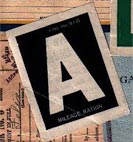
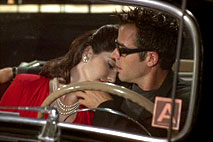 The "A"
sticker on the convertible in Adam's movie is a WW II gas rationing sticker:
"During World
War II...Gasoline for use in cars at home was rationed, and a gas rationing
sticker bearing the letter A, B or C was displayed in the windshield.
"A" meant that trips were not essential, "B" indicated
someone who needed to use the car for his work, and "C" was issued to
those whose car was essential, such as doctors. Nonessential users were limited
to three gallons of gas per week..." »more
The "A"
sticker on the convertible in Adam's movie is a WW II gas rationing sticker:
"During World
War II...Gasoline for use in cars at home was rationed, and a gas rationing
sticker bearing the letter A, B or C was displayed in the windshield.
"A" meant that trips were not essential, "B" indicated
someone who needed to use the car for his work, and "C" was issued to
those whose car was essential, such as doctors. Nonessential users were limited
to three gallons of gas per week..." »more
Given that Gasoline rationing ceased with end of WW II, the convertible scene is to be set in the mid 1940s.
-
Integrated music groups (two Negro and two white backup singers) as seen in the early 1960s set piece of the "Sylvia North Story" are unlikely for the period.
